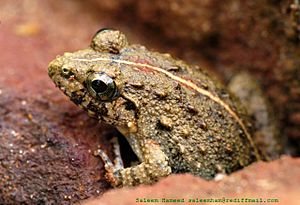Fejervarya limnocharis facts for kids
Quick facts for kids Cricket Frog |
|
|---|---|
 |
|
| A Cricket Frog from South India | |
| Scientific classification | |
| Kingdom: | |
| Phylum: | |
| Subphylum: | |
| Class: | |
| Order: | |
| Family: | |
| Genus: |
Fejervarya
|
| Species: |
F. limnocharis
|
| Binomial name | |
| Fejervarya limnocharis |
|
| Synonyms | |
|
Rana limnocharis |
|
The Cricket Frog (scientific name: Fejervarya limnocharis) is a small, interesting frog species. You can find these frogs living in many parts of South Asia. They are known for their unique calls, which sound a bit like crickets chirping. This is how they got their common name!
Contents
Meet the Cricket Frog!
Cricket Frogs are usually quite small. They grow to be about 2 to 4 centimeters (0.8 to 1.6 inches) long. Their skin can be different shades of brown, gray, or olive green. This helps them blend in with their surroundings. They often have darker spots or stripes on their backs. Their skin can also feel a bit warty.
These frogs have long, strong legs. This helps them jump far and quickly. They also have webbed toes, which are great for swimming. Their eyes are usually large and golden. This helps them see well, especially at night.
Where Do Cricket Frogs Live?
Cricket Frogs are found across a wide area in Asia. Their home includes countries like India, China, Japan, and many parts of Southeast Asia. They love places with water. You can often spot them near ponds, lakes, and slow-moving streams. They also live in rice fields and wet grasslands. These areas provide plenty of food and places to hide.
They are very adaptable. This means they can live in different kinds of environments. They can even be found in areas changed by humans. This includes gardens and ditches. As long as there is enough moisture, they can thrive.
What Does a Cricket Frog Eat?
Cricket Frogs are carnivores. This means they eat other animals. Their diet mainly consists of small insects. They love to munch on flies, mosquitoes, and beetles. They also eat other tiny invertebrates. These include spiders and worms.
They are active hunters. They usually wait patiently for their prey. When an insect comes close, they quickly snap it up. They use their long, sticky tongues to catch their food. This hunting method is very effective for them.
The Cricket Frog's Life Cycle
Like all frogs, Cricket Frogs go through an amazing life cycle. It starts with eggs. The female frog lays her eggs in water. These eggs are usually laid in small clusters. They often attach to plants or debris in the water.
From Egg to Tadpole
After a few days, the eggs hatch into tiny tadpoles. Tadpoles look very different from adult frogs. They have a round body and a long tail. They breathe using gills, just like fish. Tadpoles spend their time swimming and eating algae. They grow bigger and bigger during this stage.
Metamorphosis: Becoming a Frog
As tadpoles grow, they start to change. This process is called metamorphosis. First, their back legs begin to grow. Then, their front legs appear. Their tail slowly gets shorter. Their gills disappear, and they start to breathe with lungs. Finally, they lose their tail completely. They are now tiny froglets. These young frogs then leave the water. They begin their life on land.
Are Cricket Frogs in Danger?
The Cricket Frog is currently listed as a species of "Least Concern." This is good news! It means their populations are stable. They are not considered to be at high risk of extinction. This is partly because they can live in many different places.
However, like all animals, they face some challenges. Habitat loss is a concern. This happens when their homes are destroyed. Pollution from chemicals can also harm them. It is important to protect their watery habitats. This helps ensure these fascinating frogs continue to thrive.

